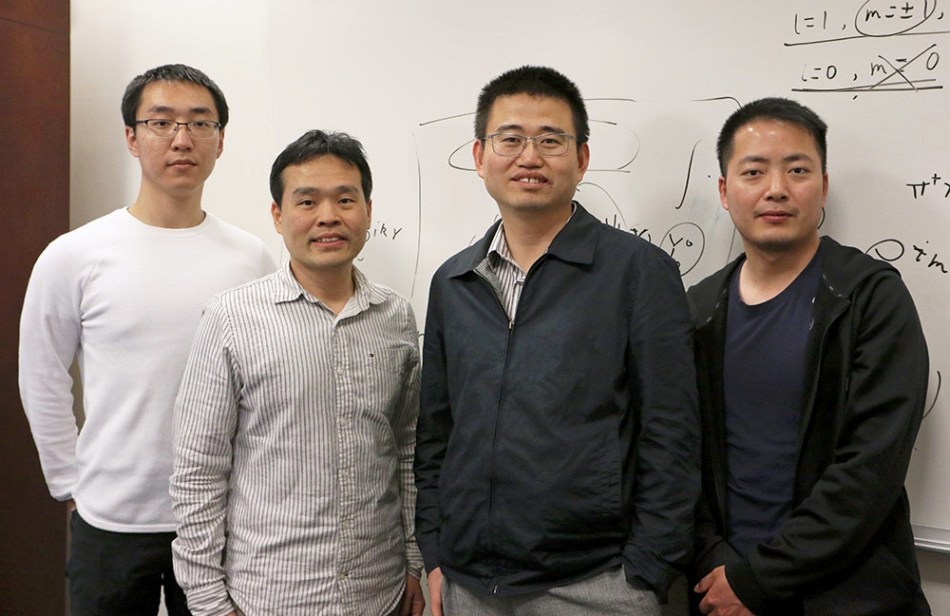Apr 11 2018
“Superfluid quasicrystal” sounds like something a villain in a comic-book might use to launch his devious plans. In reality, this term is a new form of matter suggested by theoretical physicists at The University of Texas at Dallas in a new study reported in the Physical Review Letters journal. Their research also describes a “recipe” for creating the exotic materials in the lab.
 From left: The research team includes doctoral student Junpeng Hou; Dr. Kuei Sun, senior lecturer; Dr. Chuanwei Zhang, professor of physics; and Dr. Haiping Hu, a postdoctoral research associate. (Image credit: The University of Texas at Dallas)
From left: The research team includes doctoral student Junpeng Hou; Dr. Kuei Sun, senior lecturer; Dr. Chuanwei Zhang, professor of physics; and Dr. Haiping Hu, a postdoctoral research associate. (Image credit: The University of Texas at Dallas)
The three major states of matter: solid, liquid, and gas are commonly known to most people. There are, in fact, several more, including plasma, which is present within the sun and other stars, and Bose-Einstein condensates, which are very thick and exist only in the most extreme cold temperatures.
A superfluid is an exotic state of matter with uncommon properties. It possesses zero viscosity, which means it can flow across a surface and not slow down — or lose any energy — because of friction with the surface. Superfluids, such as liquid helium, must be cooled to very low temperatures for such properties to materialize.
If your morning coffee was a superfluid, and you stirred it with a spoon, you could remove the spoon and the coffee would never stop moving. Regular fluids will eventually stop due to friction with the cup.
Dr. Chuanwei Zhang, Corresponding Author & Professor of Physics in the School of Natural Sciences & Mathematics
Both a Superfluid and a Quasicrystal
About five decades ago, researchers suggested a new type of matter that blended the properties of a superfluid with those of a solid crystal. Termed a supersolid, it is only in the past few years that scientists have been able to create that rare material in the lab.
In physics, we have a very strict definition of what a fluid is and what a solid is. Liquid water cannot behave as a solid, and vice versa. They can be mixed together, for example in a glass of ice water, but they are still separate forms of matter.
Dr. Chuanwei Zhang, Corresponding Author & Professor of Physics in the School of Natural Sciences & Mathematics
In the realm of quantum physics, which describes how matter acts at the level of atoms and individual particles, this is not always correct, Zhang said.
“A supersolid is a fluid flowing without friction whose atoms are also arranged in a periodic way, just as they are in a crystal solid,” he said. “These two states, which are mutually exclusive in our everyday life, can exist at the same time in the same physical material in the quantum world.”
In their recent study, Zhang and his colleagues propose the next logical step — planning a new type of matter that is both a quasicrystal and a superfluid.
A crystal, like table salt, has atoms that are organized in a very ordered, periodic pattern that is unaffected when rotated or repeated, Zhang said. A checkerboard can be imagined as a two-dimensional (2D) crystal. Quasicrystals, on the other hand, are materials whose atoms are ordered and possess structure like in a crystal, but their arrangement is not periodic — it does not repeat.
“We asked the question, can you have a new quantum matter state that is both a quasicrystal and a superfluid?” Zhang said.
The answer is affirmative, at least from physical standards, Zhang said.
The material Zhang and his colleagues suggest should flow without friction while also displaying a non-periodic, quasicrystal structure.
This is a theory at the moment, but in this paper we suggest an experimental setup similar to the experiment that produced the first supersolids. The good news is, we shouldn’t have to invent any new technology to actually make this material. It basically involves shooting lasers at a Bose-Einstein condensate.
Dr. Chuanwei Zhang, Corresponding Author & Professor of Physics in the School of Natural Sciences & Mathematics
Junpeng Hou, the study’s lead author and a physics PhD student at UT Dallas, said producing the material could still prove to be tough.
“It can take several years for new supersolids to become experimentally realized,” Hou said. “But I believe our system would not take that long, maybe one or two years.”
Other authors of the research are Dr. Kuei Sun, senior lecturer in physics, and Dr. Haiping Hu, a postdoctoral research associate in physics.
The Air Force Office of Scientific Research, the National Science Foundation, and the Army Research Office provided funding for the research.